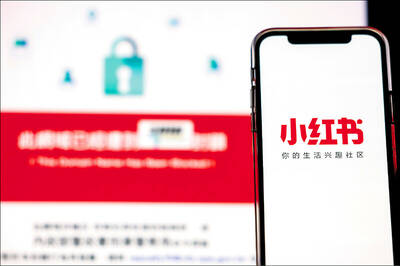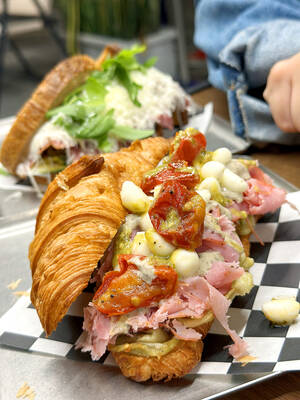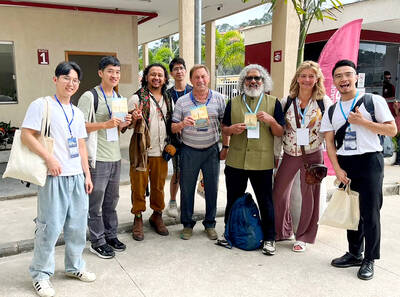At the Eslite Bookstore in Xinyi District, tens of thousands of books in the art section have been wrapped in decorated pink sheets of paper that hide any possible indication of their content. A project by Michael Lin (林明宏), 21.2.1972 is the artist’s latest exploration of the relationship between art and spectators.
Feb. 21, 1972 is “the date when US president [Richard] Nixon visited Mao Zedong (毛澤東),” explained Lin, who emigrated to the US with his family in 1973. “There is this photograph of Mao sitting in his library. The books on the shelf behind him are all wrapped up. For some reason the image has stuck in my mind.”
The prints of phoenixes and peonies that decorate the pink wrapping paper are similar to images Lin used for his huge floor paintings that were exhibited at the 2000 Taipei Biennial. The relationship between the bookstore’s customers and its books is altered as browsers have to open books at random to find out what’s inside each one. In this way, they invariably come across books they wouldn’t ordinarily look at.
“People buy the books and take them home. How long the book remains an artwork in someone’s home is a question I can’t answer,” Lin said.
A similar motif runs through Lin’s solo exhibition I Am the Sun (我是太陽), currently on display at the Eslite Gallery (誠品畫廊), which has just moved to a space in Eslite’s flagship Xinyi store that is three times larger than its old location at Eslite’s branch on Dunhua South Road (敦化南路).
Internationally known for his brightly colored murals and enormous, ornate paintings based on traditional Taiwanese floral prints, Lin has relocated to Shanghai and Paris but often visits home to look for new sources of inspiration. The muse for his this show is the sun cake (太陽餅), a pastry that Lin sees as a symbol of Taiwan.
The artist was intrigued by the numerous shops in Taichung that claim to be Tai Yang Tang (太陽堂), the purported inventor of the sun cake, seeing contradiction and ambiguity between claims of originality and the act of duplication. By reproducing Tai Yang Tang’s logo and trademark on canvas, he created a pattern that appears both familiar and alien at the same time, and which suggests that the idea of tradition is a playful construct.
“The logo and trademark of Tai Yang Tang can be read as a [symbol] of identity, just like a national flag. Their graphic elements are rearranged to form an empty frame, thus encouraging viewers to fill in the blanks with any name and image they can imagine,” Lin said.
Ambiguity is also treated in paintings based on the covers of notebooks used in Taiwan’s elementary schools. For Lin, Zhuyin Fuhao (注音符號, Bopomofo), the system used to teach Mandarin phonetics to young Taiwanese students, is a written language that has yet to come into being, a happenstance that echoes a student’s quest for identity during adolescence.
Also on display are two oversized tangrams, a kind of Chinese puzzle, painted with images of Bambi. Unlike jigsaw puzzles, the open-form tangram can be arranged into all kinds of shapes and patterns. Lin’s Bambi versions are an invitation for audiences to participate in the making of art.
“The distinction between contemporary and modern art is that [the latter] is divorced from everyday life. That my works suggest and think of an audience to converse with is an important aspect of my art,” Lin said.
Free sun cakes will be given to those whose purchases total NT$600 or more at bookstores or NT$3,000 at other shops at Eslite branches across Taiwan until the end of the month. Lin suggests that people pause before gobbling down the cake.
“You are the one who decides when the art begins and when it ends,” he said. “You eat the sun cake. It has a lot of sugar so you get a bit wired. Then you ask, ‘Is this sensation also an element of art, an effect that art can achieve?’”

This month the government ordered a one-year block of Xiaohongshu (小紅書) or Rednote, a Chinese social media platform with more than 3 million users in Taiwan. The government pointed to widespread fraud activity on the platform, along with cybersecurity failures. Officials said that they had reached out to the company and asked it to change. However, they received no response. The pro-China parties, the Chinese Nationalist Party (KMT) and Taiwan People’s Party (TPP), immediately swung into action, denouncing the ban as an attack on free speech. This “free speech” claim was then echoed by the People’s Republic of China (PRC),

Exceptions to the rule are sometimes revealing. For a brief few years, there was an emerging ideological split between the Democratic Progressive Party (DPP) and Chinese Nationalist Party (KMT) that appeared to be pushing the DPP in a direction that would be considered more liberal, and the KMT more conservative. In the previous column, “The KMT-DPP’s bureaucrat-led developmental state” (Dec. 11, page 12), we examined how Taiwan’s democratic system developed, and how both the two main parties largely accepted a similar consensus on how Taiwan should be run domestically and did not split along the left-right lines more familiar in

Specialty sandwiches loaded with the contents of an entire charcuterie board, overflowing with sauces, creams and all manner of creative add-ons, is perhaps one of the biggest global food trends of this year. From London to New York, lines form down the block for mortadella, burrata, pistachio and more stuffed between slices of fresh sourdough, rye or focaccia. To try the trend in Taipei, Munchies Mafia is for sure the spot — could this be the best sandwich in town? Carlos from Spain and Sergio from Mexico opened this spot just seven months ago. The two met working in the

Many people in Taiwan first learned about universal basic income (UBI) — the idea that the government should provide regular, no-strings-attached payments to each citizen — in 2019. While seeking the Democratic nomination for the 2020 US presidential election, Andrew Yang, a politician of Taiwanese descent, said that, if elected, he’d institute a UBI of US$1,000 per month to “get the economic boot off of people’s throats, allowing them to lift their heads up, breathe, and get excited for the future.” His campaign petered out, but the concept of UBI hasn’t gone away. Throughout the industrialized world, there are fears that